

It was as if the rats had behaviorally imposed symmetry on the physically asymmetrical environment. However, in the asymmetrical layout with 4 objects, additional key locations were spaced by the rats between the objects, forming symmetry among the key locations. Viewing 'location' as a cluster of stopping coordinates, the key locations (large clusters of stopping coordinates) were at the objects in both layouts with 4 objects. Principal Findings: While there were only minor activity differences between rats tested in the symmetrical or asymmetrical object layouts, network analysis revealed substantial differences. We considered locations as the units of the network (nodes), and passes between locations as the links within the network. Methodology: We applied network analysis to scrutinize spatial behavior of rats tested in either a symmetrical or asymmetrical layout of 4, 8, or 12 objects placed along the perimeter of a round arena. Background: We set out to solve two inherent problems in the study of animal spatial cognition (i) What is a "place"? and (ii) whether behaviors that are not revealed as differing by one methodology could be revealed as different when analyzed using a different approach.


 0 kommentar(er)
0 kommentar(er)
